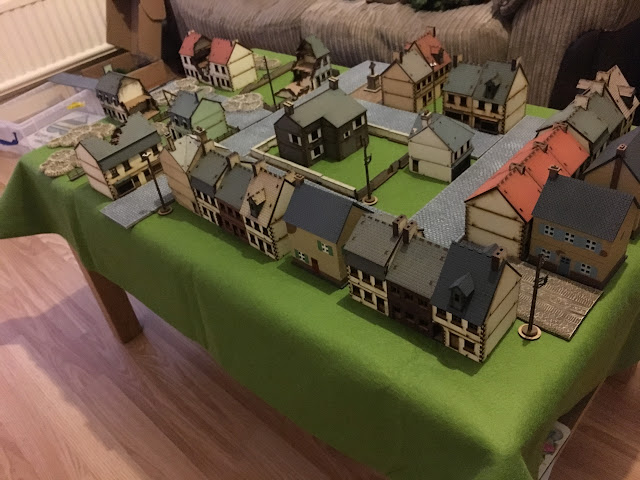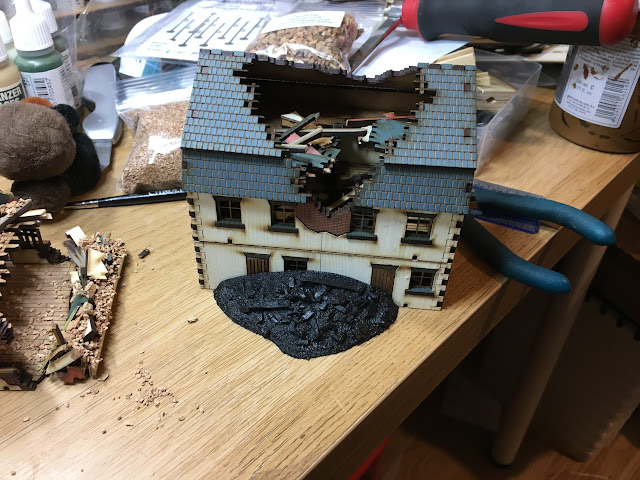Lots of blog posts this weekend, as a few different things have popped up.
While some lucky people got to go to Salute yesterday and see/buy lots of nice things, I was out in the garden getting covered in PVA and static grass. Yet another battle in my fight to upgrade my battlefields and make all the time and effort spent painting models be reflected in the quality of the gaming table I (plan to) own!
I have, I accept, a long way to go. But even the last few days has shown progress can be made.
Yesterdays efforts started with some work being done to my GF9 'Battlefield in a box' terrain. Specifically my various road sections:
I've added the static grass I use for my standard basing to the dirt tracks (perhaps a little too heavily...) and to the edges of the cobbled sections. I'm thinking of doing a little work to the crater sections to have them match the craters in my minefields. A coat of German Camo Medium brown, a drybrush of beige brown and then a very light drybrush of Buff might do the trick! I'll have a think on it as they are really OK as they are. I'm also thinking of adding the usual tufts and flowers...
I also turned them over and sprayed the undersides with Matt varnish. I've had issues with them sticking together in places and causing damage due to this. I think it was because some of the resin was showing through the paint, so I'm hoping a coat of varnish will sort that out!
I also got my minefields finished - some step by step pictures:
 |
| And the 4 separated out. |
 |
| 'Clean' Minefields but with signage. I've 6 of these. |
Then, I did a little more work on my ruined houses. Mainly getting the roof colours to match, painting doors and doing other small bits of detailing. I've marked the bottom of the various ruin sections and houses with the building number and the level of the building the ruin marker is for.
 |
| Repainted the undamaged side of house, and roof. I've another building like this so wanted to make them different. Painted doors and window details. |
 |
| Repainting the roof also meant that some of the rubble bits were a different shade, so I gave them a quick running over in order to have it all match. |
 |
| I gave the roof here another coat after looking at this picture. The 'cuts' in the MDF really soak in paint! Painting the roofs also make some of the assembly pegs less visible. |
Lastly, I finished off the Telegraph poles.
I added a 25mm base to the bottom of these, and milliputted around the give weight and make the surface a little smoother. I've another 9 of these to build. Transport for these is a issue as they are fragile. I'm thinking of using the same technique as my vehicles and magnetising the bases to stand upright, but they are taller than most of the boxes I have. The transport of the buildings offers the same issue!
I also started work on my fields. These are fairly iconic for the Normandy fighting, I think. I totally appreciate that my based tanks are going to look weird sitting on top of this stuff, but that's just one of the issues with any sort of basing. I've got a LOT of this stuff to do....
One thing I did find - I have been using some purchased resin rubble piles for the larger sections at the sides of my buildings, but had some milliput spare the other night. I clipped off some of the building sprues and found this made and excellent base to build on with the milliput. So if your thinking of doing your own ruins, that might be a cheaper way of building up the height you need:
 |
| A clipping from the 4Ground sprue, with milliput applied. It doesn't look much now, but once I detail up the surface with more sprue and cork rubble, it will fit right in! |
I'll try to get some more fields sorted, as these will help clutter up the map space. I'll also see what buildings I am taking and what work needs done to them. This will, currently, mainly be roof painting I think.
Thanks for all the positive feedback guys, hints and tips are always appreciated!

























































